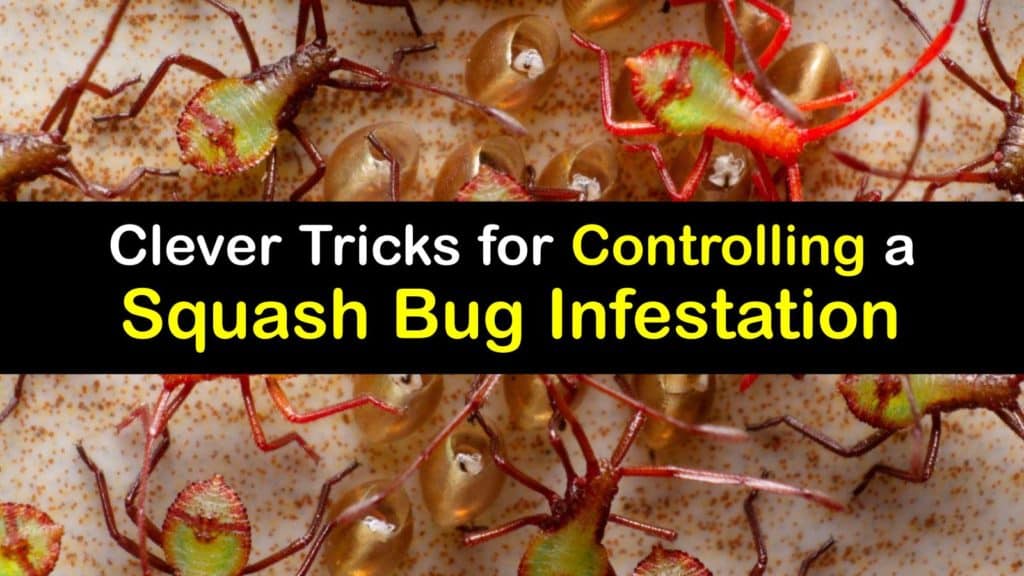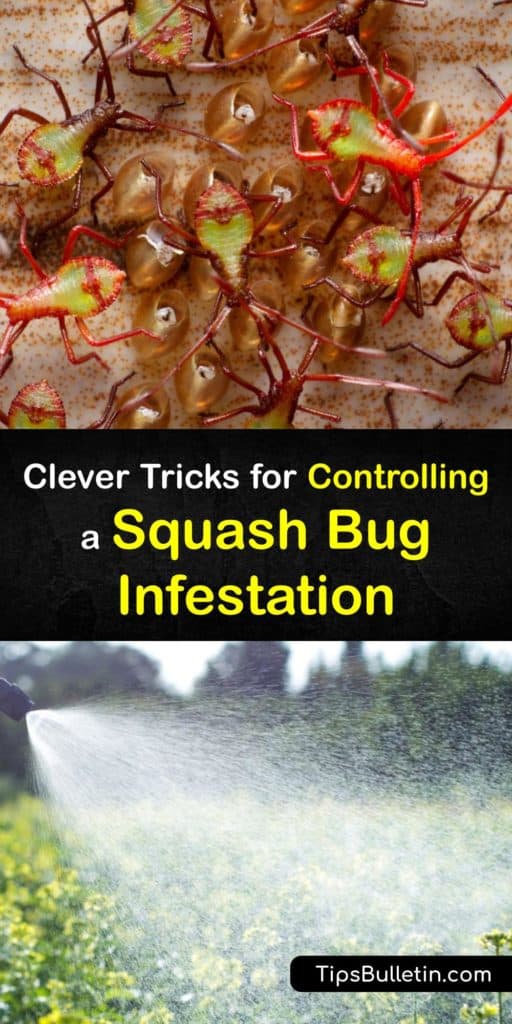When growing squash or members of the Cucurbitaceae family of crops, you may find your garden overrun by small grey or dark brown insects. These are squash bugs, and they commonly feed on seedlings and young plants. Without knowledge on how to deal with a squash bug infestation, the presence of these insect pests means the death of your plants.
Squash bugs (Anasa tristis) are a species of bugs belonging to a family of sap-sucking insects. In North America, the frequent presence of these bugs on cucurbit crops gave rise to the name squash bugs, though other species share this name.
These bugs are typically found on pumpkins and squash but have varying degrees of success reaching adulthood on other host plants like melons and cucumbers.

Ways to Stop Squash Bugs
By feeding on the sap of plants, squash bugs damage the plant’s vascular tissue and leaves, causing them to die eventually. It should go without saying that a large population of adult squash bugs or an infestation causes a large amount of damage to your squash.
Although a bug infestation may seem daunting to deal with in your vegetable garden, our article can help—methods for controlling a squash bug infestation, or if you are infested by kissing bugs, range from non chemical treatments to pest control methods that use insecticide.
Early detection and regular maintenance help avoid an infestation from taking over your summer squash.
The Biology of Squash Bugs
At first glance, adult squash bugs may look like stink bugs with their similarly shaped flat bodies, but an adult squash bug has a more rounded body with alternating orange and brown stripes.
Female squash bugs start appearing in early June to lay egg clusters on your plants throughout the summer. The squash bug nymphs that emerge have light green bodies with black heads and legs. As they grow, their colors shift, turning light grey then brown-grey as they progress into adulthood.

In the fall, once the vines of your squash plant die, adult bugs and nymphs gather on the fruit of your plant. As temperatures continue to drop into winter, adults head to sheltered places to survive freezing temperatures; however, nymphs that have not matured die in freezing temperatures.
Removing Squash Bug Eggs
One effective way to control squash bug populations is to keep the next generation of bugs from starting. Killing squash bugs at the adult stage is difficult, and removing nymphs from your plant is more of an involved process, so destroying eggs is the easiest way to prevent squash bug infestations.
Female squash bugs lay eggs in clusters of 15 to 40 from June through late summer, and removing these clusters is an essential step in squash bug control.
Squash bug eggs range in color from yellow, bronze, brown, or red and are around 1/16 inch and found on the underside of your plant’s leaves where the leaf’s veins form a V.
Remove eggs from the leaf by brushing them off and into a bucket of soapy water to ensure the eggs are dead. While wearing gloves, a squash bug egg is easily crushed between your fingers once picked off the leaf; however, they release an unpleasant smell when crushed.
Another easy way squash bug prevention strategy is to keep a new generation of nymphs from hatching by brushing the eggs off into a sealed plastic bag and dispose of the eggs.
Squash bug eggs take about ten days to hatch, so check your plant for new clusters regularly. If you are diligent about removing eggs throughout the summer, you’ll find yourself in the fall without any new nymphs and a smaller population to manage.
Handling Squash Bugs with Insecticide
Using insecticides for squash bug control is not always necessary as other methods work well for controlling an infestation. If you notice severe damage to your cucurbits or your plant is damaged early in the growing season, using a pesticide may be needed to manage the pests.
Insecticides work well against squash bug or kissing bug nymphs as they are more vulnerable to insecticides than adults. Most insecticides readily available to home gardeners are not effective against adult squash bugs.
We recommend spraying under your plant’s leaves as this is where squash bugs are typically found. Spray in the morning or late at night when beneficial insects are not active.
Neem oil is a natural pesticide easily found in garden centers or online. Neem oil comes from the seeds of the neem tree and effectively kills a variety of pests. The best way to get rid of squash bugs naturally is to spray the oil on all leaf and stem surfaces according to label directions. This is a way to repel squash bugs and to kill those already present.
Note: Follow label directions for any pesticide you use and only use on the vegetables listed on the label for the pesticide you purchase.
Crop Care and Planting to Control a Squash Bug Infestation
After removing eggs and any squash bug nymph that has already hatched, focus on getting rid of adults to prevent more egg clusters. Easy and somewhat passive ways to stop squash bugs and keep them from being cucumber pests are regular crop care and companion planting.
While nymphs die in freezing temperatures, some bugs overwinter in the area where crops grow. Rotating where you plant crops helps avoid this by not planting your squash in the same spot. Additionally, cleaning up plant debris removes any potential areas for bugs to overwinter and will effectively get rid of zucchini bugs before they become a problem.
While winter squash may not be in as much danger for pests due to their growing season, when planting squash in the summer, look into varieties of squash that are resistant to pests. Common varieties like butternut squash, royal acorn, and crookneck are more resistant to squash bugs than others.
Some cucurbit crops are desirable to pests like squash bugs and the squash vine borer. Planting trap crops or specific varieties along the perimeter of your garden helps keep pests like the vine borer away from the rest of your squash.
Trap cropping is not a new idea – one that stems from the concept of companion planting to help crops grow better or keep harmful insects away. Squash bug traps are easy, effective, and a primarily hands-off approach to keeping your desirable plants safe.
According to the Lincoln University IPM program research, Blue Hubbard squash is attractive to squash bugs and works well to draw in other pests like cucumber beetles. Unlike squash bugs, cucumber beetles carry diseases, so keeping them away from your cucurbits helps reduce infection of diseases like bacterial wilt. Use this plant and others as natural cucumber beetles traps to keep them off your wanted plants.
Squash Bugs in the House
Like most insects, squash bugs flee when humans are near or their area is disturbed. This fleeing nature makes dealing with an infestation difficult as the pests hide under leaves and move quickly if their host plant is bothered.
Hiding squash bugs makes dealing with an infestation of squash bugs in the house difficult as you don’t want the pests seeking shelter on other plants or in areas of your home that are difficult to reach. You can also use plants that repel squash bugs to keep them out of the house.
To avoid using harsh chemicals to deal with squash bugs in the house and control the squash bug population effectively, make an insecticidal spray.
For a soap spray, avoid dishwashing liquids and instead use gentle soaps like Ivory Snow or Ivory Liquid. To make this homemade squash bug spray, combine one gallon of water with soap in a spray bottle and use immediately on your plant leaves. It also works great to prevent leaf miners. Spritz directly on visible insects.
When choosing soaps, avoid any with added fragrances to avoid causing unintentional harm to your plants while looking for ways to stop squash bugs.
The addition of oil is unnecessary for your spray to work; however, it helps its effectiveness and shelf life, especially when using neem oil to kill squash bugs. Add oil and soap and when you’re ready to use, mix one teaspoon of this base for each cup of water used and spray immediately.
To increase the use of your soap spray, purchase sulfur in liquid form. Using this, create a new soap spray following the instructions on your sulfur label to create a mixture of the proper concentration. The addition of sulfur makes your spray an effective fungicide to use against powdery mildew and downy mildew.
Squash Beetles
Another common pest to keep an eye out for is squash beetles. Unlike most other lady beetles, squash beetles are a problem because they feed on the leaves of plants in the squash family.
Squash Beetle Infestation
While ladybugs are beneficial insects that act as natural predators for harmful pests in your garden, squash beetles are the opposite. Squash beetles are yellow with black spots and may be mistaken for cucumber beetles, but they are more round.
Squash beetle eggs are laid similarly to squash bugs on the underside of leaves but in larger clusters. These eggs resemble the eggs of helpful beetles, so leaving them to hatch may cost you in the long run.
Squash beetles do not typically harm the fruit of the host plant, but adults and larvae feed on the underside of plants, making them hard to spot. If left to feed, an infestation reduces the leaves of your plants into a skeleton of veins, affecting your plant’s ability to take in sunlight for growth.

A squash bug infestation means serious problems for your vegetable garden, so please consider sharing our ways to stop squash bugs with your fellow gardeners on Facebook and Pinterest.